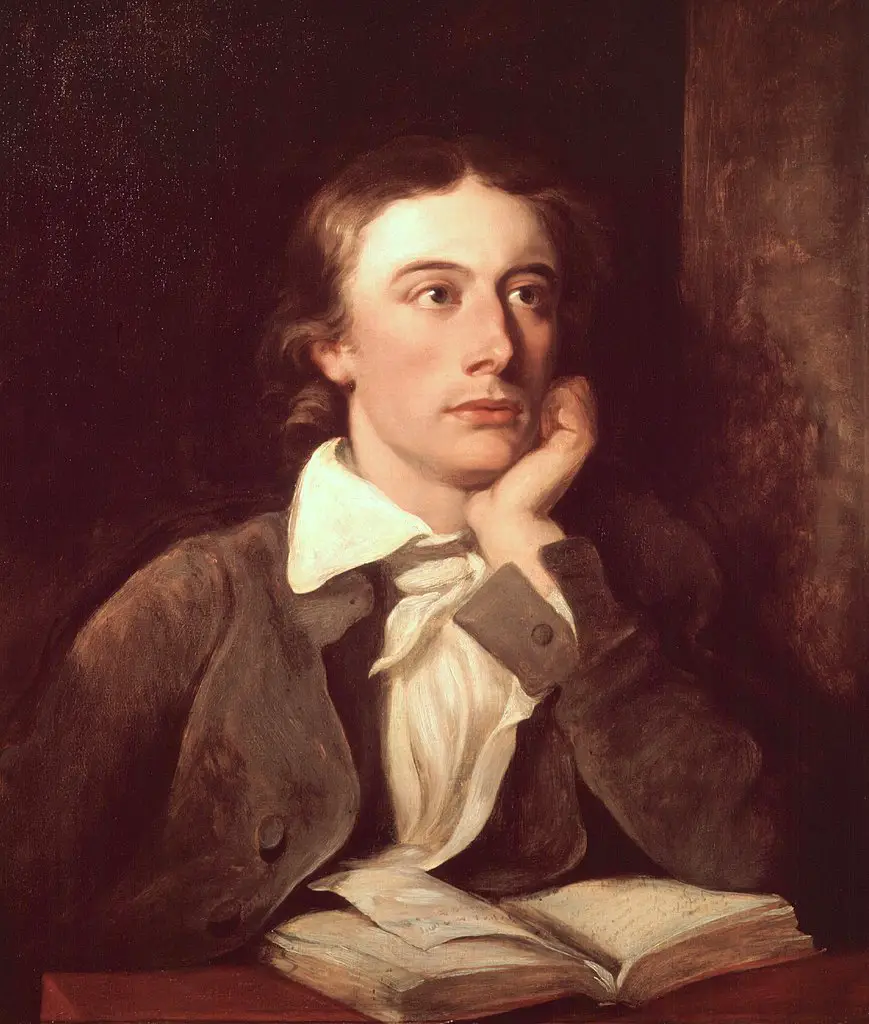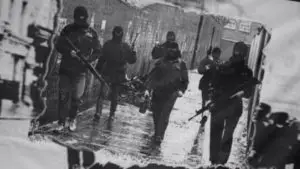
FULL POEM - SCROLL DOWN FOR LINE-BY-LINE ANALYSIS
O what can ail thee, knight-at-arms,
Alone and palely loitering?
The sedge has withered from the lake,
And no birds sing.
O what can ail thee, knight-at-arms,
So haggard and so woe-begone?
The squirrel’s granary is full,
And the harvest’s done.
I see a lily on thy brow,
With anguish moist and fever-dew,
And on thy cheeks a fading rose
Fast withereth too.
I met a lady in the meads,
Full beautiful—a faery’s child,
Her hair was long, her foot was light,
And her eyes were wild.
I made a garland for her head,
And bracelets too, and fragrant zone;
She looked at me as she did love,
And made sweet moan
I set her on my pacing steed,
And nothing else saw all day long,
For sidelong would she bend, and sing
A faery’s song.
She found me roots of relish sweet,
And honey wild, and manna-dew,
And sure in language strange she said—
‘I love thee true’.
She took me to her Elfin grot,
And there she wept and sighed full sore,
And there I shut her wild wild eyes
With kisses four.
And there she lullèd me asleep,
And there I dreamed—Ah! woe betide!—
The latest dream I ever dreamt
On the cold hill side.
I saw pale kings and princes too,
Pale warriors, death-pale were they all;
They cried—‘La Belle Dame sans Merci
Thee hath in thrall!’
I saw their starved lips in the gloam,
With horrid warning gapèd wide,
And I awoke and found me here,
On the cold hill’s side.
And this is why I sojourn here,
Alone and palely loitering,
Though the sedge is withered from the lake,
And no birds sing.

LINE-BY-LINE ANALYSIS
STANZA 1
O what can ail thee, knight-at-arms,
Alone and palely loitering?
The sedge has withered from the lake,
And no birds sing.
The first stanza introduces the two characters (the knight and a mysterious unknown speaker) and the surroundings of the poem. Written from the perspective of the unknown speaker, we learn of the ill (‘palely loitering’) knight and his barren, bleak surroundings. The season is winter as the ‘sedge (a type of plant) has withered from the lake’. In literature, the imagery of winter is a pathetic fallacy for death. The fact that ‘no birds sing’ further emphasises the bleak, hostile, unnatural environment and implies a lack of harmony in nature.
STANZA 2
O what can ail thee, knight-at-arms,
So haggard and so woe-begone?
The squirrel’s granary is full,
And the harvest’s done.
The unknown speaker seems sympathetic to the ‘haggard’ and ‘woe-begone’ knight. The adjective ‘haggard’ defines exhaustion and fatigue and ‘woe-begone’ describes the knight as suffering from extreme sorrow. The collective use of these adjectives portrays the physical and emotional decline of the knight, perhaps signifying the state of Keats when writing this poem. The optimistic imagery of the ‘granary is full’ is a metaphor for the fruits and fullness of life at the time, however, this is juxtaposed by the finished harvest.
STANZA 3
I see a lily on thy brow,
The imagery of ‘lily’ is a metaphor for the paleness of the man and can be
interpreted as a symbol of death.
With anguish moist and fever-dew,
The adjective ‘anguish’ again depicts the man in a state of physical and
emotional torment and the imagery of ‘moist’ and ‘dew’ describes the man as
if his health resembles the barren winter landscape.
And on thy cheeks a fading rose
This line can be interpreted physically and psychologically, physically as the colour in his cheeks and with it his strength is fading. And psychologically as the love and passion that roses often symbolise is fading – is his likeness of the speaker decreasing or his faith in humankind as a whole?
Fast withereth too.
The verb to wither is defined as something falling into decay or decline and is a motif of the poem –
whether it be the plants dying or the physical and emotional strength of the knight
STANZA 4
I met a lady in the meads,
The poem shifts to the knight talking in the first person, reliving what happened to him in response to his companion’s questions. He starts off by saying he met a
woman in the ‘meads’ (meadow) and this is how his anguish originated.
Full beautiful—a faery’s child,
He describes the woman as beautiful and a fairy’s child. When the poem was written in 1819 there was a widespread belief that exceptionally pretty children were left by fairies.
Her hair was long, her foot was light,
Taken literally, the woman being ‘light of foot’ conforms and reinforces the
description of the woman as an ethereal fairy and this description is common
in supernatural tales.
And her eyes were wild.
Her ‘wild eyes’ signify an element of madness and disobedience in the woman,
foreshadowing the downfall of the man.
STANZA 5
I made a garland for her head,
A ‘garland’ is a wreath of flowers worn on the head. The knight makes it as a symbol of his love for the beautiful woman.
And bracelets too, and fragrant zone;
A ‘fragrant zone’ is a belt made of flowers. It is the crescendo of the tricolon list and could, hence, show his progression from her head to waist and with it a progression to sex. If we’re going with sex, the ‘fragrant zone’ could be a euphemism for the woman’s genitals.
She looked at me as she did love,
And made sweet moan
The following two lines describe the knight and the woman making love, with her sounds of ‘sweet moan’ being sounds of pleasure. Structually it’s significant, as with the climax of the fifth stanza comes the climax and reward of his gifts and advances for her.
STANZA 6
I made a garland for her head,
A ‘garland’ is a wreath of flowers worn on the head. The knight makes it a symbol of his love for the beautiful woman.
And bracelets too, and fragrant zone;
A ‘fragrant zone’ is a belt made of flowers. It is the crescendo of the tricolon list and could, hence, show his progression from her head to waist and with it a progression to sex. If we’re going with sex, the ‘fragrant zone’ could be a euphemism for the woman’s genitals.
She looked at me as she did love,
And made sweet moan
The following two lines describe the knight and the woman making love, with her sounds of ‘sweet moan’ being sounds of pleasure. Structurally it’s significant, as with the climax of the fifth stanza comes the climax and reward of his gifts and advances for her.
STANZA 7
She found me roots of relish sweet,
And honey wild, and manna-dew,
The imagery of the plants juxtaposes the bleak, wintery imagery in the first two stanzas, giving a sense of warmer times, fresh with new life and romance.
And sure in language strange she said—
The ‘strange language’ of the woman implies that something unnatural is at play and fortifies the notion that there is something deceitful about the woman.
‘I love thee true’.
Despite the woman saying that she loves the knight, we cannot be sure it is genuine as it is said in a ‘strange language’ and something must lead to his downfall after all.
STANZA 8
She took me to her Elfin grot,
At the beginning of the eighth stanza the tone of the poem shifts, as the woman takes control in their relationship. Prior to this, the knight was very much the controlling figure as it was him making things for her and setting her on his ‘pacing steed’. Now that she is in control by taking him to her ‘grot’ (a cave), it makes him seem more vulnerable.
And there she wept and sighed full sore,
Suddenly the poem shifts from a romantic tone to a tragic one as the woman begins to cry. However, the cause of this tragedy as unknown – maybe she knows of his future demise or that they can not be together if it is taken literally that she is a fairy.
And there I shut her wild wild eyes
The control shifts back to the knight as he shuts her eyes. This has sinister undertones as after someone dies their eyes are closed. When reading on we learn that she has not died so, instead, this moment could foreshadow the death of one of them.
With kisses four.
STANZA 9
And there she lullèd me asleep,
The woman resumes control, as we presume she’s reopened her eyes and is now lulling the knight asleep. The word ‘lulled’ further suggests deception like the phrase to lull someone into a full sense of security – this is quite possibly what’s happening here.
And there I dreamed—Ah! woe betide!—
If you can remember back to the second stanza, the unknown speaker described the man as ‘woe-begone’ this repetition of ‘woe’ is a good hint that these events and those just after them brought him into the decline we witnessed at the start of the poem.
The latest dream I ever dreamt
The repetition of ‘dream’ heightens the vulnerability of the knight as it emphasises the fact that the knight is removed from reality and, hence, vulnerable to threats in the real world. It is also described as his ‘latest dream’. Is it his last ever dream which would foreshadow his impending death?
On the cold hill side.
There’s a lot of uncertainty on how he reached the hill side from the elfin grot, did he leave the grot before he was lulled to sleep or was he transported whilst he was sleeping. The ‘cold hill side’ does seem remote, isolated, and brutal making the man seem more at risk.
STANZA 10
I saw pale kings and princes too,
These ‘kings’ and ‘princes’ are the characters in his dream. Their high status highlights the tragic demise of the knight from being a strong, masculine knight to being lulled asleep on a cold hill side by a beautiful woman.
Pale warriors, death-pale were they all;
The ‘warriors’ personify the strength he once had and juxtaposes his current weakness. The paleness of them reinforces the imagery of death and weakness.
They cried—‘La Belle Dame sans Merci
Translated into English “La Belle Dame sans Merci” is “the beautiful woman without pity”. In his dream, the warriors, kings, and princes warn him about the woman and the danger she’s placed him in.
Thee hath in thrall!’
This is old English and basically means that the woman has the knight in her power.
STANZA 11
I saw their starved lips in the gloam,
‘Gloam’ is old English for twilight. This is a pathetic fallacy for the ending of life, just like the twilight is the ending of a day. The ‘starved lips’ of these men further emphasise their weakness and could be alluding to the men being dead.
With horrid warning gapèd wide,
This unnatural, sinister imagery of the men’s mouths as ‘gaping wide’ is unsettling and just adds to the menacing situation.
And I awoke and found me here,
On the cold hill’s side.
The knight wakes up and is unsure as to why he is here and what has happened. It seems like he may have cheated and avoided death but Keats reminds us that he is still on the ‘cold hill side’ repeating that he is not out of the woods yet.
STANZA 12
And this is why I sojourn here,
As a verb, ‘sojourn’ is defined as to stay somewhere temporarily. We can assume that he has remained on the hill side and this is where the unknown narrator is spreading to him. The language suggests he is waiting for something – that something could be death or the beautiful woman.
Alone and palely loitering,
Keats clearly iterates the demise of the knight here, the repetition of ‘paleness’ maintains the motif of weakness and potential death.
Though the sedge is withered from the lake,
And no birds sing.
In the last two lines of the twelfth stanza, the last two lines of the first stanza are repeated, making the narrative go full circle, returning to the knight speaking to the unknown narrator. This signifies the lack of progression in the life of the knight now – maybe his waiting is just for death.


